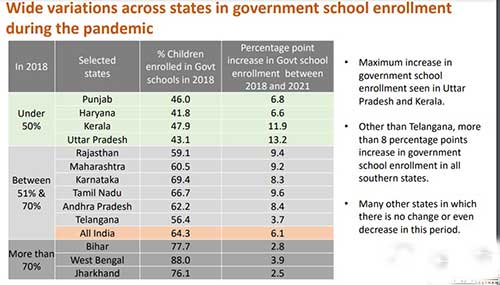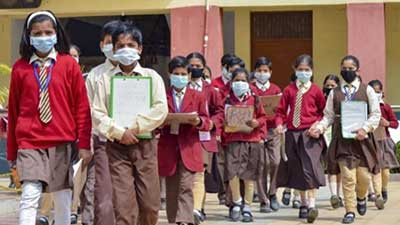Key Phrases: GS-2: Issues relating to the development and management of Social Sector/Services relating to Health, Education, Human Resources.
Key phrases: Public School, ASER 2021, Drop out, Economic Survey 2022, Pratham NGO, financial distress
Why in News?
- One of the most prominent observations of the Economic Survey 2022 with regards to Education Sector is that during the COVID-19 pandemic, more students have moved to Government Schools from Private Schools. While to some, this might be something to think about, it must be noted that this outcome is at the backdrop of a reduced 'School Drop-out rate.'
Important findings from the ASER 2021 report:
- According to the report, there has been an overall increase in the proportion of children enrolled in govt schools between 2018 and 2020 i.e from 64.3% to 65.8%. However, in the year 2021, the enrollment suddenly went up to 70.3%.
- The enrolment rate in private schools has however gown down from last year. In 2020, the enrolment rate was 28.8% and in 2021 the enrolment rate went down to 24.4%.
- According to the report, even though availability of smartphones increased from 36.5% in 2018 to 67.6% in 2021, more children in private schools had smartphone at home (79%) compared to government school going children (63.7%).
- ASER 2021 also pointed out that there was a 40% increase in the number of school going children taking tuition during the closure of their schools amid the pandemic.
- The report was prepared on the basis of the telephonic survey conducted in rural areas of 581 districts across 25 states and three union territories between September and October. As many as 76,706 households, 7,299 schools in 17,184 villages across India were covered in the survey.


Annual Status of Education Report (ASER)
- It is an annual survey that aims to provide reliable annual estimates of children’s schooling status and basic learning levels for each state and rural district in India.
- It has been conducted every year since 2005 in almost all rural districts of India. It is the largest citizen-led survey in India.
- It is conducted by Pratham, a non-government organization.
- It includes children who have never been to school or have dropped out, as well as those who are in government schools, private schools, religious schools, or anywhere else.
Reason for Students moving to Government Schools:
Annual Status of Education Report, ASER 2021-22 found that at the backdrop of all this, more and more students have shifted to Government schools. This phenomenon has especially been observed among children in rural areas across all 3 age groups alike. Some possible reasons for this, as per the Survey are:
• Many low-cost private schools have shut down during the pandemic. This could've urged these students to enroll in Government schools.
• COVID-19 pandemic has caused financial distress to many people, if not all. This problem could also be a reason for students shifting to Government schools, where fees is less.
• This is being attributed to the closure of schools in the pandemic and the inability of parents to opt for government schools where the fee is almost nil compared to the huge fee structure in private schools. The low incomes in the pandemic is one of the reasons for the shift.
• Migration, especially back to villages or home towns was seen a lot during the pandemic. This could also be another reason of students either shifting or going to their villages and enrolling in Government schools.
• High fees of Private schools and relatively more free facilities in Government schools could also be some other motivating factors of increased enrollment in sarkari schools.
• According to the report, 52% of the respondents, including teachers and principals in govt schools, cited financial distress caused by the pandemic as the reason behind the increase in govt school enrollments, another 50% said that it was because of the free facilities available at the government schools, 40% of them said that private schools’ failure to conduct online classes led parents to move their children to public schools; while 15% said migration during the lockdown was the reason behind the shift.
Challenges to Government School education in India
- Lack of qualified teachers is one of the biggest problems in most schools, both government and private schools in India. This is because teaching is always the last career option for most young career people. They choose teaching as a career but unfortunately, teachers of government schools get posted to rural areas. It’s a known fact that they will either go on leave or apply for immediate transfer.
- The IQ level of an average private school student is a lot higher than the average government primary school student due to the difference in many factors. The teachers are ignorant about the child’s future. This is a serious matter which the government needs to address.
- There is also neglect, insufficient public financing and accountability, and a lack of encouragement among some teachers to pay special attention to poor children from lower castes. Even basic amenities like water and electricity lack in such schools.
- The school environment is so suffocating that the students are dissuaded from attending the classes which is why the dropout rate is also high.
- Several reports suggest that nearly 70% of students studying in government schools are ill-equipped to learn in the class they are admitted to.
Way Forward:
- If the reverse migration from private schools continues, the survey called for enhanced support to the government run school system like additional support “in terms of teacher-pupil ratio, classroom space, and teaching/ learning materials, to absorb students migrating from private schools and from urban to rural areas.”
- Pointing out that access to education, school drop outs, learning gaps especially for children from marginalized communities have always remained major challenges in education, the academic disruption due to the pandemic and subsequent to online learning becoming the safe and prominent mode of learning, it aggravated the existing digital divide and thus access to education.
- In this Scenario government has to enhance its role to provide quality education to its people.
- In the last five years, the Delhi model of education has caught the attention of people in Delhi and beyond. Other states government has to learn from this and should provide a good government education system in their state.
Article 21-A : The Constitution (Eighty-sixth Amendment) Act, 2002 inserted Article 21-A in the Constitution of India to provide free and compulsory education of all children in the age group of six to fourteen years as a Fundamental Right in such a manner as the State may, by law, determine.
Article 45 : In the Constitution mandates the state shall endeavour to provide, within a period of ten years from commencement of this Constitution, for free and compulsory education for all children until they complete the age of fourteen years.
Fundamental duties 51A.: It shall be the duty of every citizen of India who is a parent or guardian to provide opportunities for education to his child or, as the case may be, ward between the age of six and fourteen years.
UN SDG 4 is "Ensure inclusive and equitable quality education and promote lifelong learning opportunities for all.”
Source: Timesnownews
Mains Question:
Q. During the COVID-19 pandemic, more students have moved to Government Schools from Private Schools. Discuss main reasons behind it ? If it will continues then how should government step up public school capacity? Illustrate.







